Kalantzopoulou, Tina. "Narratives of Mountainous Areas in the Aegean: Prehistoric Remains on the Mountains of East Crete and the Political Geography of Minoan Crete." CHS Research Bulletin 11 (2023). https://nrs.harvard.edu/URN-3:HLNC.ESSAY:103377757
Early Career Fellow in Hellenic Studies 2022-23
Introduction
Although archaeological research has revealed a densely occupied landscape on the coastal and the hilly zone of Crete during the Bronze Age, the uplands have been largely overlooked despite comprising almost 50% of the total area of the island. The starting point for this post-doctoral study was the extensive surface survey carried out on the mountainous hinterlands of Ierapetra, as part of the excavation at Gaidourophas, and Zakros, under the Minoan Roads Research Project, during 2015-2017. On Dikti, the survey covered the sloped area between the modern villages of Malles and Kalamafka, at an altitude from 800m to 1100m amsl; in Zakros, it covered the karstic landscape around the modern village of Sitanos from altitudes of 600m to 800m amsl. The survey yielded new sites dating from the Final Neolithic to the Late Bronze Age (Kalantzopoulou 2022 a; Kalantzopoulou 2022 b). Architecture and pottery documented and studied from each site allowed the examination of settlement patterns, forms of occupation and exploitation on the upland areas of East Crete (Kalantzopoulou in Press a; Kalantzopouou in Press b; Papadatos and Kalantzopoulou 2022; Kalantzopoulou and Papadatos forthcoming), which up to that point were considered economically marginal (Albough 1954; Hertzfeld 1985; Chaniotis 1999).
The principal aim of my postdoctoral research, facilitated by the 2022-2023 fellowship with the CHS, is the understanding of the nature of mountainous landscapes occupation (Papadatos and Chalikias 2019) and the reconstruction of their importance for and their relationship with state-level economies of the lowlands (Evans 1921-1936). During my appointment, I worked on analyzing further the results of the 2015-2017 survey through archaeological, historical, and anthropological parallels (Watrous 1982; Blitzer 1990; McNeil 1992; Forbs 1995; Haggis 2002, 2005; Hayden 2004). My aim was to offer new, more insightful, interpretations and the results’ integration in broader historical narratives reconstructed for the Aegean Bronze Age (Driessen and Letesson 2023). At the same time, I focused on the continuation of the fieldwork, expanding the survey on Dikte mountain (fig 1) with the aim of revisiting previously poorly documented upland sites (Beckmann 2012).
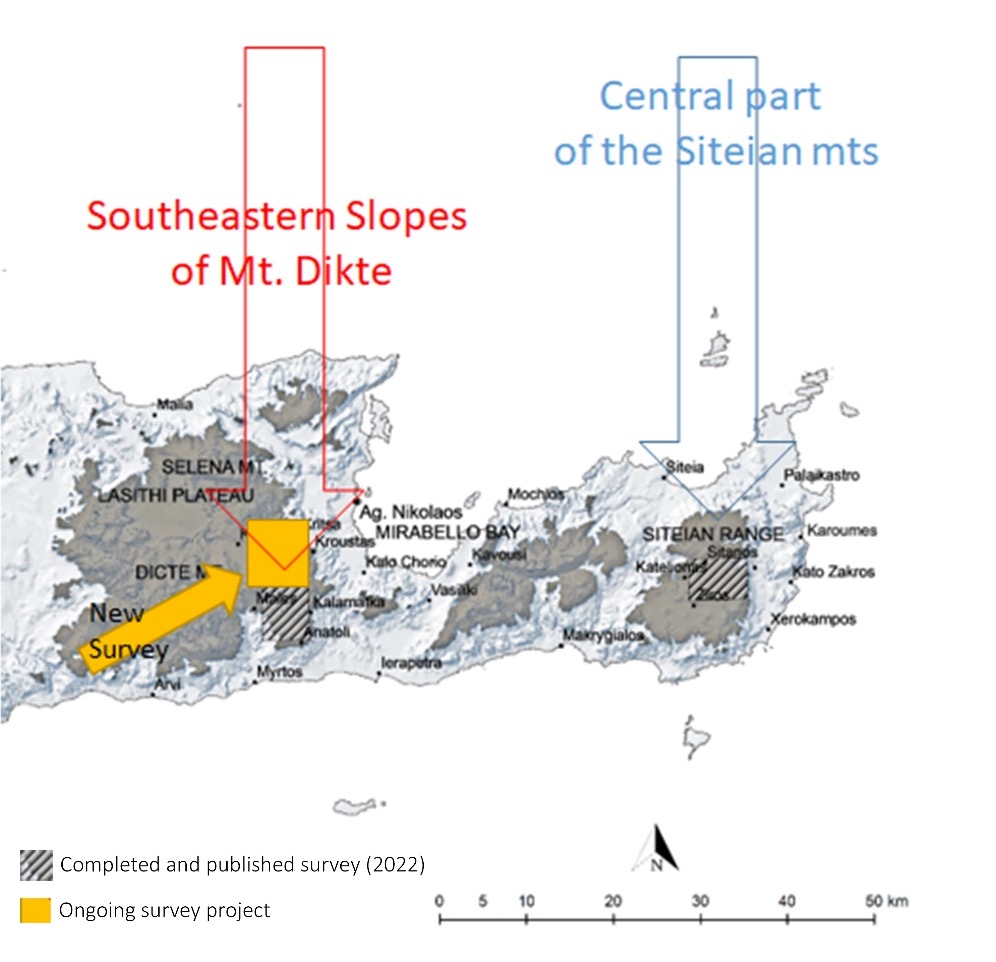
The new survey
In 2022 the first field-campaign of the new survey, under a 5-year permit with the National and Kapodistrian University of Athens (NKUA), was executed. This time focusing exclusively on the eastern part of Dikte range in East Crete, on altitudes from 600 to 1200 m. The team under my supervision consisted of the PhD candidate at the University of Cambridge A. Xenaki, the MA student at NKUA E. Vereketi and several undergraduate students of NKUA. The whole fieldwork lasted for 5 weeks in July and August as part of a larger survey project directed by Prof. Y. Papadatos (fig 2). During the survey 138 sites were documented, of which more than 90 included architectural prehistoric remains (fig 3.). Architecture, which in many cases featured megalithic buildings (Shaw 2009), was documented using a DGPS, drone imaging and data collection in a systematic manner to facilitate the creation of plans, architectural and landscape reconstructions (fig 4). The evaluation of the date and character of the sites was aided from the study of the movable finds that were sampled systematically for each site.
After the first fieldwork campaign we proceeded with the analysis of the raw data, creating orthophoto maps of all architectural remains and stone-by-stone digital plans. The pottery sampled from all 138 sites is currently being studied. The units have been sorted by fabrics and ceramic recipes, recognizing provenance of the clay and typological analysis is employed to establish chronology and the variety of shapes repertoire revealing of sites’ functions (fig 5). In preparation of a publication of all data and results at the end of this project, characteristic pottery sherds are being droughted. The post-survey study is executed by me and Prof. Y. Papadatos with the help of the MA student Nikita Dauby of the University of Louvain la Neuve.
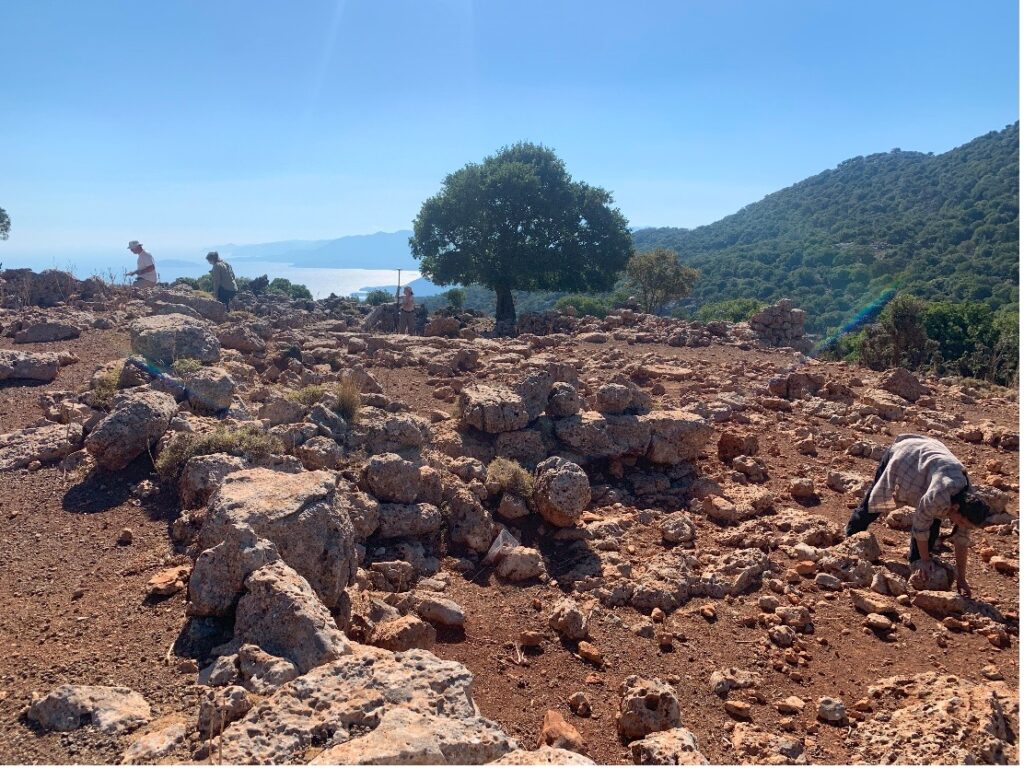
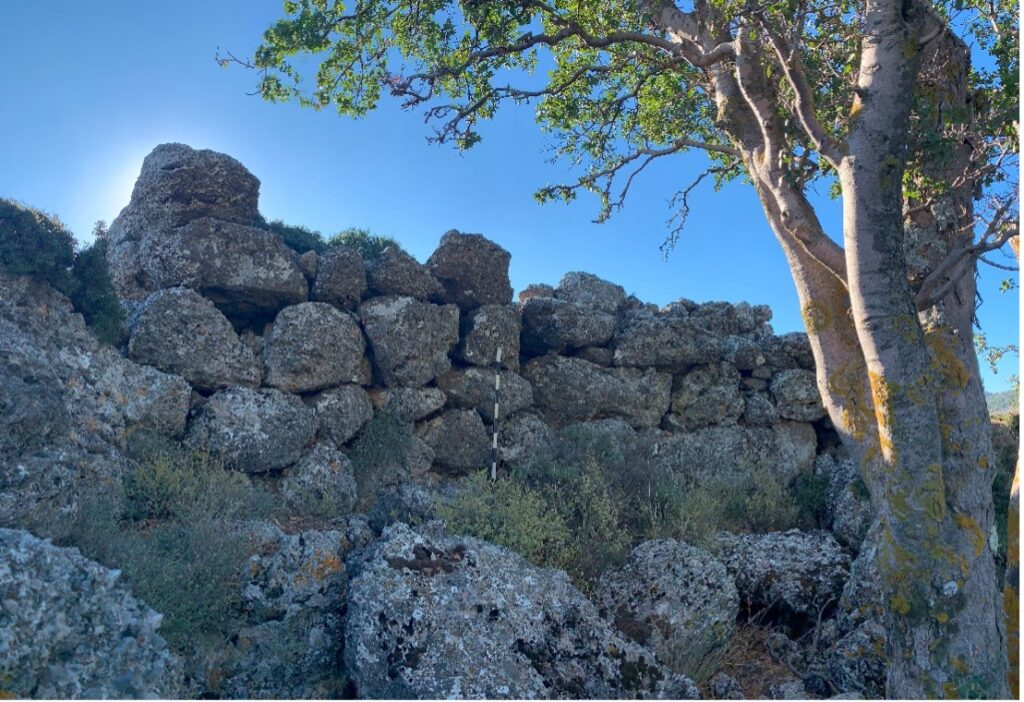
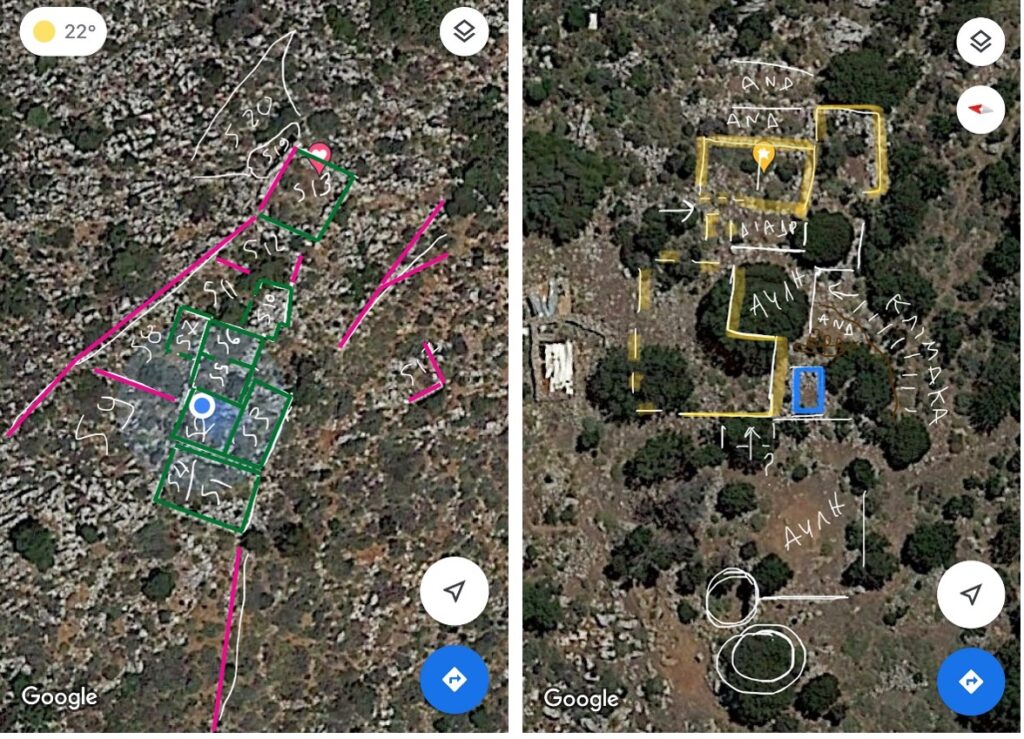
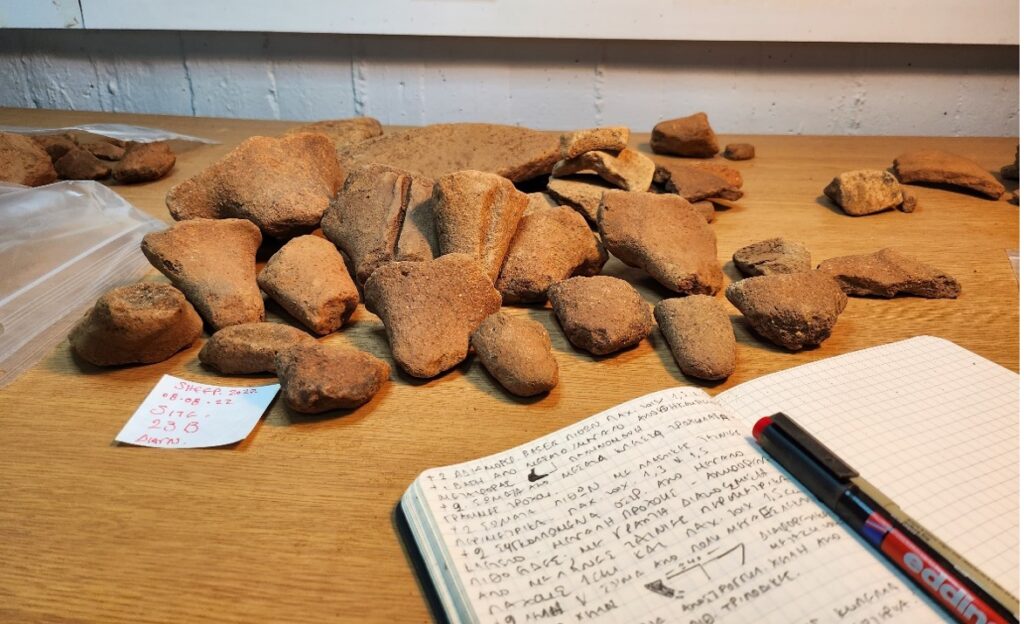
The discussion
The preliminary results of the new survey are complimenting the work on interpretation and the effort to contextualize the new body of sites. Our view is that mountain colonization is a phenomenon of the LBA and as such it is meaningful for the understanding of the political interplay of this period developed between the Minoan palaces (Evans 1921-1936, Driessen 2021; Driessen and Letesson 2023), as major political actors, and the inhabitants of the hinterland as major economic actors (Chryssoulaki 1999, 2009; Vokotopoulos 2011; Vokotopoulos et al 2014, Vokotopoulos 2022) and hence in some cases as peers. Our data confirm that the maximum dispersal of settlements in the mountainous countryside is not a Protopalatial feature and this contrary to prevailing views about the dispersal in the rural hinterland in general (cf. Müller-Celka et al. 2014; cf Beckmann 2012). Upland colonization is a process and that started at the beginning of the Neopalatial period.
Experienced groups with internal specialization are required for marginal colonization showing mechanisms of collective action (Driessen and Relaki 2020). Especially on the mountains, where the conditions are harsh and both the agricultural and the pastoral production need sizable and time enduring groups (see Chaniotis 1999; Halstead and Isaakidou 2011; Jouffroy-Bapicot et al 2016). In need, there are three sites where we observed a very tight spatial arrangement, with a dozen of megalithic farmhouses working together as a unit, hinting that the initiative to occupy the mountainous zone was organized through larger groups that stuck together and pooled their resources (see Letesson and Driessen 2020). Additionally, in several instances we observe that these clusters of farmhouses are connected through a system of auxiliary structures, which are indicative of extensive landscaping efforts, including pastoral installations, large enclosures, communication routes and stone-build roads and restricted areas reserved for outdoor human activities – other than animal husbandry – such as small-scale cultivation in orchards and storage (Kalantzopoulou 2022, 76-83).
A cooperative attitude between the groups colonizing the upland zone between 700-1100 m and the lowland communities, who benefitted from the relocation of the flocks, is also attested. Such practices are indicated by the large quantities of pottery with regional character recovered from the mountains sites, representing the import of vessels as a supplement in the highlanders’ subsistence with essential commodities, taking advantage of Crete’s mild winters and the fragmentation of the landscape into several micro-environments allowing intensive exploitation with the flocks permanently based on the uplands.
Of course, since excavation evidence are still lacking from the mountain megalithic farmhouses, we are not certain about the foundation and the abandonment chronological sequences of these structures, but based on surface pottery we believe that their longevity is in fact attested by the establishment of a different type of building: that of the rural “villa”. This political transformation during which administrative outposts are established throughout the rural hinterland is a phenomenon of the mature LM IA-early LM IB period (see van Effenterre and van Effenterre 1997) and it reaches the mountains as soon as the political organization of the Second Palace period became consolidated (Papadatos and Kalantzopoulou 2022).
On the surveyed areas in mountain Dikte, this phenomenon is emphasized by an already excavated LM I (late) Building at Gaidourophas. This is clearly the seat of a high official that possesses the full range of administrative paraphernalia: such as a bronze signet ring, stone seals, scrap metal, spaces with significant storage capacity and ‘high’ architecture (Papadatos and Chalikias 2019; Papadatos and Kalantzopoulou 2022). However, it is its temporal aspect that is important here. Its foundation, we believe, represents an effort to regulate the already existing production of the dispersed and clustered farmhouses, which were documented through survey. We suggest that this building is imposed in LM IB upon an already up-and-running productive system – that of the preexisting megalithic farmhouses. In fact, there is good evidence to support that some of the clusters at high altitudes are established in MM III and are still operational in LM IB, while some of the structures are undergoing architectural modifications during that period. This practically means that we have actors dwelling and producing in these structures for almost 7 to 10 generations.
On the uplands of Sitanos, on the other hand, there were no remains of neither the Protopalatial period nor of the early Neopalatial (Kalantzopoulou 2022, 14-35, 92-95). There were neither clusters nor isolated farmhouses. But the area experiences a transformation later in the Neopalatial – well into the LM I – when the Zakros palace was established. During that period, most probably in LM IB, four different buildings and building complexes of the rural “villa” type are founded simultaneously and we believe that they represent an effort to increase production in this area with a system designed and executed in a single movement, unlike the Dikte example. If there was indeed no productive community established on the uplands beforehand, hindered by poor visibility, we may envisage a scenario in which certain families or groups decided or were commissioned to systematically exploit this area by actually moving into it. The exploitation pattern here seems to be more centralised than on Dikte, employing fewer buildings to occupy an area of almost equal size, but with arguably a much larger cultivation capacity.
Eventually, we either choose to see this as a purely economic move orchestrated by the palace or – following the “House Society” theory (Driessen and Relaki 2020) – we understand that the emergence of a palatial-type center in Zakros stirs the social competition among pre-existing OIKOI forcing them to establish physical manifestations of themselves on the uplands. Such a scenario would mean that the upland “villas” on the Sitanos-Ziros area were just outposts engaged in feeding the palace with certain products, from a mixed economic model since the buildings are located to strategically overlook arable karstic valleys. Viticulture (see Livarda et al 2021) and animal husbandry products for varied purposes are here among our best guesses, but so it happens that these two products were also very important in communal feasting practices – hence important to the rituals of social reproduction and social negotiation (see Hamilakis 1996). This final observation we believe strengthens our interpretation of the social predicament of the mountain dwellers, not necessarily as provincial but as part-takers in the “staged” negotiations of political power through the control of a separate productive zone (see Driessen and Letesson 2023).
As far as production and economy are concerned, in both study areas, the large variety of mountain-specific products, such as wood and other foraged goods, (see Harissis 2017; Tsakanika 2017; Ntinou 2021; Kalantzopoulou in press b) would not have gone unnoticed by the palaces. Nevertheless, assuming that an important part of this production was related to pastoralism (see Burke 2010 a, 2010 b), it is very well possible that we are in fact witnessing on the mountains of east Crete the predecessor of the system revealed by the Linear B tablets regarding systematic animal husbandry during LM III in central Crete, as Palmer (1995) had suggested. The question though remains: what can we say for the political organization, rather than the economy?
The reconstructed shepherds of Lavrakia on Dikte, living in what looks like a web of inter-connected farmhouses and the “landlords” of Sitanos uplands practicing mixed economy in scattered rural “villas” that control a small arable valley each and presumably their surrounding slopes, are not so contradictive after all. This is particularly evident, if we consider them as emerging through different trajectories but prevailing as integrated and interdependent units. In our mountainous habitation discourse we explore the possibility that these marginal habitats may not represent the physical and organizational extension of palatial economic structuring stricto sensu; but may represent a phase of reconsolidation or re-expression of dominant Minoan kinship corporate groups, which by establishing themselves on unknown (or even mythical) landscapes attempt to legitimize their participation in socioeconomic and political structures of the palace itself (Kalantzopoulou in prep.). While ultimately, they have found a territorial and an economic niche from which to draw their differentiated identity, which will in turn allow them to compete as peers within palatial context.
Dissemination of the results
During my appointment I have presented preliminary results in the EEA international conference held in September 2022 in Budapest, to the Belgian Day of Geek Archaeology held in December 2022 in Brussels, a day that was dedicated to Prof. Jan Driessen. In this occasion I had the chance to present for the first time my theory about the significance of the mountain occupation for the political organization of Neopalatial Minoan society. My work was presented, also in December 2022, in Washington to the fellows of CHS, an experience that broadened my horizons both in academia and culturally. In February 2023, I submitted a manuscript entitled “Mountainous Forested Areas of East Crete and the Upland Pastoral and Agro-pastoral Communities of the Late Bronze Age” for peer-review and subsequent publication in 2024 (Pallas), in volume, with the title: “Bois et architecture dans la Protohistoire et l’Antiquité (2) Approvisionnement en bois, activités agro-pastorales et couvert forestier edited by Lamouille S., Pagnoux C., Saragaglia V. & Rougier-Blanc S”. Finally, I presented my work in a specialized conference discussing the integration of pastoralist communities to the Bronze Age palatial establishments, held in March 2023in Rome. Another fieldwork campaign will follow in July 2023 and an article is currently in preparation and will soon be submitted to AJA for peer-review.
Selected bibliography
ALLBAUGH, L. G., 1953, Crete, a Case Study of an Underdeveloped Area, Princeton.
BECKMANN, S., 2012, Domesticating Mountains in Middle Bronze Age Crete: Minoan Agricultural Landscaping in the Agios Nicolaos Region, PhD diss., University of Crete.
BLITZER, H., 1990, Pastoral Life in the Mountains of Crete, Expedition 32, p. 34-41.
BURKE, B., 2010 a, Textile Production in the Aegean Bronze Age, in E. H. Cline (ed.), The Oxford Handbook of the Aegean Bronze Age (ca. 3000-1000 BC), Oxford, p. 430-442.
BURNS, B. E., 2010 b, Trade, in E. H. Cline (ed.), The Oxford Handbook of the Aegean Bronze Age (ca. 3000-1000 BC), Oxford, p. 291-304.
CHANIOTIS, A. 1999, Milking the mountains: economic activities on the Cretan uplands in the Classical and Hellenistic period, in A. Chaniotis, (ed.), From Minoan Farmers to Roman Traders: Sidelights on the Economy of Ancient Crete (HABES 29), Stuttgart, p. 181-220.
CHRYSSOULAKI, S., 1999, Ερευνητικό πρόγραμμα «Μινωικοί Δρόμοι», ΕΥΠΠΟ 2, p.163-165.
CHRYSSOULAKI, S. 2009, Ερευνητικό Πρόγραμμα «Μινωικοί Δρόμοι», ArchDelt 55, Chronika, 1046-1049.
DRIESSEN, J. 2021, Revisiting the Minoan palaces: ritual commensality at Sissi, Antiquity 95, 381, p. 686-704.
DRIESSEN, J. AND LETESSON, Q., 2023, The Gathering: Collectivity and the Development of Bronze Age Cretan Society, Journal of Archaeological Research, pp.1-58.
DRIESSEN, J. AND RELAKI, M., 2020, OIKOS: Archaeological Approaches to House Societies in Aegean Prehistory. Louvain.
EVANS, A., 1921-1936, The Palace of Minos at Knossos, I-IV and Index Volume, London.
FORBES, H., 1995, The Identification of Pastoralist Sites within the Context of Estate-Based Agriculture in Ancient Greece: Beyond the ‘transhumance versus agro-pastoralism’ debate, BSA 90, p. 325-338.
HAGGIS, D.C., 2002, Integration and Complexity in the Late Prepalatial Period: A View from the Countryside in Eastern Crete, in Y. Hamilakis (ed.), Labyrinth Revisited: Rethinking Minoan Archaeology, Oxford, p. 120-142.
HAGGIS, D.C., 2005, Kavousi I: The Archaeological Survey of the Kavousi Region (Prehistory Monographs 16), Philadelphia.
HALSTEAD, P. & V. ISAAKIDOU, 2011, Revolutionary secondary products: the development and significance of milking, animal-traction and wool-gathering in later prehistoric Europe and the Near East, in T. C. Wilkinson, S. Sherratt & J. Bennet (eds), Interweaving Worlds: Systemic Interactions in Eurasia, 7th to 1st Millennia BC, Oakville, p. 61-76.
HAMILAKIS, Y., 1996, Wine, Oil and the Dialectics of Power in Bronze Age Crete: A Review of the Evidence, OJA 15, p. 1-32.
HARISSIS, H., 2017, Beekeeping in prehistoric Greece, in F. Hatjina, G. Mavrofridis & R. Jones (eds), Beekeeping in the Mediterranean from Antiquity to the Present, Nea Moudania, p. 18-39.
HAYDEN, B. J., 2004, Reports on the Vrokastro Area, Eastern Crete. Volume 2: The Settlement History of the Vrokastro Area and Related Studies (Philadelphia Museum Monographs 119), Philadelphia.
HERZFELD, M., 1985, The poetics of manhood: contest and identity in a Cretan mountain village. Princeton.
JOUFFROY-BAPICOT, I., VANNIÈRE, B., IGLESIAS, V., DEBRET, M. AND DELARRAS, J.F., 2016. 2000 years of grazing history and the making of the Cretan mountain landscape, Greece, PloS one, 11(6).
JOUFFROY-BAPICOT, I., PEDROTTA, T., DEBRET, M., FIELD, S., SULPIZIO, R.,ZANCHETTA, G. et al., 2021, Olive groves around the lake. A ten-thousand-year history of a Cretan landscape (Greece) reveals the dominant role of humans in making this Mediterranean ecosystem, Quaternary Science Reviews, 267.
KALANTZOPOULOU, T. 2022 a, Taking the High Road. Prehistoric Habitation and Exploitation in the Mountains of East Crete: New Evidence from an Extensive Survey (Aegis 22), Louvain-la-Neuve.
KALANTZOPOULOU, T. 2022 b, Living on the Edge: habitation on the uplands of East Crete: Preliminary results from an extensive survey, in South by Southeast: The History and Archaeology of Southeast Crete – from Myrtos to Kato Zakros. Conference Proceedings [1-2 June 2017], E. Oddo and Κ. Chalikias (eds.), Archaeopress, Oxford, pp. 25-36.
KALANTZOPOULOU, T., The History of Human Activity on the Sitanos Uplands during Prehistory: The case of Kastri, Proceedings of the 5th International Meeting for the Archaeological Work in Crete, [21-24 November 2019], Rethymno, In press a.
KALANTZOPOULOU, T., Mountainous Forested Areas of East Crete and the Upland Pastoral and Agro-pastoral Communities of the LBA, in Bois et architecture dans la Protohistoire et l’Antiquité (2) Approvisionnement en bois, activités agro-pastorales et couvert forestier, 2022, In press b.
KALANTZOPOULOU, T., The Poetics of the House: Mountain-dwelling and minoan political identities, In preparation.
KALANTZOPOULOU, T. AND Y. PAPADATOS, Outdoor Spaces and the Organization of Production on the Cretan Uplands: a Mountain Perspective of Neopalatial Administration, in Outdoors of Aegean Prehistory. Conference Proceedings[16-17 May 2018], Ε. Hatzaki and P. Zafeiriadis (eds.), Oxbow, Oxford, Forthcoming.
LIVARDA, A., H. A. ORENGO, N. CAÑELLAS-BOLTÀ, S. RIERA-MORA, L. PICORNELL-GELABERT, V. TZEVELEKIDI, R. VEROPOULIDOU, R. MARLASCA MARTÍN, A. KRAHTOPOULOU, 2021, Mediterranean polyculture revisited: Olive, grape and subsistence strategies at Palaikastro, East Crete, between the Late Neolithic and Late Bronze Age, JAnthArch 61.
LETESSON, Q. & J. DRIESSEN 2020, ‘On the House’: A diachronic look on the configuration of Minoan Social relationships, in OIKOS: Archaeological Approaches to House Societies in the Bronze Age Aegean (Aegis 19), M. Relaki & J. Driessen, eds, Louvain-la-Neuve, 7-24.
MCNEILL, J. R., 1992, The Mountains of the Mediterranean World: An Environmental History, Cambridge.
MÜLLER-CELKA, S., D. PUGLISI & F. BENDALI, 2014, Settlement Pattern Dynamics and Natural Resources in MM – LM I Crete: The case of Malia, G. Touchais, R. Laffineur & F. Rougemont (eds), PHYSIS: Natural environment and human interaction in the prehistoric Aegean [University Paris 1 Panthéon-Sorbonne, 11-14 December 2012] (Aegaeum 37), Leuven & Liège., p. 431-440.
NTINOU, M., 2021, Woody Resources, Fuel, and Wood Use in the Late Minoan I Settlements at Mochlos, Papadiokampos, and Chryssi, in Kentro: The Newsletter of the INSTAP Study Center for East Crete, 24, p. 17-21.
PALMER, R., 1995. Linear A Commodities: A comparison of resources, in POLITEIA: Society and State in the Aegean Bronze Age (Aegaeum 12), R. Laffineur and W. D. Nieimeier eds., Liege, p. 135-155.
PAPADATOS, Y. & K. CHALIKIAS, 2019, Minoan Land-Use Patterns and Landscape Transformation in the Mountains of the Hierapetra Area: The Minoan Building at Gaidourophas, in E. Oddo & K. Chalikias (eds), Exploring a Terra Incognita: Recent Research on Bronze Age Habitation in the Southern Hierapetra Isthmus, Philadelphia, p. 79-95.
PAPADATOS, Y. & T. KALANTZOPOULOU, 2022, Turning the Landscape into Territory: strategies of power for the exploitation of the Cretan mountains during the Neopalatial period, in van Wijngaarden, G.J. & J. Driessen (eds), Political Geographies of the Bronze Age Aegean, Proceedings of the Joint workshop by the Belgian School at Athens (EBSA) and the Netherlands Institute at Athens (NIA) [30 May-1 June 2019] (Babesch Suppl. 43), Leuven, p. 31-46.
SHAW, J. W., 2009, Minoan Architecture: Materials and Technique (Studi di Archeologia Cretese 7), Padova.
TSAKANIKA, E., 2017, Minoan structural systems: earthquake resistant characteristics: The role of timber, in S. Jusseret & M. Sintubin, (eds), Minoan Earthquakes. Breaking the Myth through Interdisciplinarity (Studies in Archaeological Sciences 5), Leuven, p. 267‑304.
VAN EFFENTERRE, H. & M. VAN EFFENTERRE 1997, Towards a Study of Neopalatial ‘villas’: Modern words for Minoan things, in Hägg, ed., The Function of the “Minoan Villa”, p. 9-13.
VOKOTOPOULOS, L., 2011, A View of the Neopalatial Countryside: Settlement and social organization at Karoumes, East Crete, in K. T. Glowacki & N. Vogeikoff-Brogan (eds), STEGA: The Archaeology of Houses and Households in Ancient Crete (Hesperia Supplement 44), Princeton, p. 137-150.
VOKOTOPOULOS, L., 2022, Choiromandres: Periods of use and character of the occupation. An overview, in Proceedings of “South by Southeast” conference [Pacheia Ammos, July 2017], K. Chalikias & Ε. Oddo, eds, Oxford, p. 75-91.
VOKOTOPOULOS, L., G. PLATH and F. W. MCCOY 2014, The Yield of the Land: Soil conservation and the exploitation of arable land at Choiromandres, Zakros in the New Palace period, in G. Touchais, R. Laffineur & F. Rougemont (eds), PHYSIS: Natural environment and human interaction in the prehistoric Aegean [University Paris 1 Panthéon-Sorbonne, 11-14 December 2012] (Aegaeum 37), Leuven & Liège., p.. 251-263.
WATROUS, L. V., 1982, Lasithi: A History of Settlement on a Highland Plain in Crete (Hesperia Supplements 18), Princeton.
